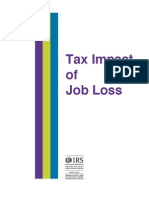The Sections of A Tax Return
The Sections of A Tax Return
Uploaded by
LJBernardoCopyright:
Available Formats
The Sections of A Tax Return
The Sections of A Tax Return
Uploaded by
LJBernardoOriginal Description:
Original Title
Copyright
Available Formats
Share this document
Did you find this document useful?
Is this content inappropriate?
Copyright:
Available Formats
The Sections of A Tax Return
The Sections of A Tax Return
Uploaded by
LJBernardoCopyright:
Available Formats
Understanding Tax Returns
In the United States, tax returns are filed with the Internal Revenue Service (IRS) or with the
state or local tax collection agency (Massachusetts Department of Revenue, for example)
containing information used to calculate taxes. Tax returns are generally prepared
using forms prescribed by the IRS or other relevant authority.
In the U.S., individuals use variations of the Internal Revenue System's Form 1040 to file federal
income taxes. Corporations will use Form 1120 and partnerships will use Form 1065 to file their
annual returns. A variety of 1099 forms are used to report income from non-employment-related
sources. Application for automatic extension of time to file U.S. individual income tax return is
through Form 4868.1 2 3
Typically, a tax return begins with the taxpayer providing personal information, which includes
their filing status, and dependent information.
The Sections of a Tax Return
In general, tax returns have three major sections where you can report your income, and
determine deductions and tax credits for which you are eligible:
Income
The income section of a tax return lists all sources of income. The most common method of
reporting is a W-2 form. Wages, dividends, self-employment income, royalties and, in many
countries, capital gains must also be reported.4
Deductions
Deductions decrease tax liability. Tax deductions vary considerably among jurisdictions, but
typical examples include contributions to retirement savings plans, alimony paid, and interest
deductions on some loans. For businesses, most expenses directly related to business operations
are deductible. Taxpayers may itemize deductions or use the standard deduction for their filing
status. Once the subtraction of all deductions is complete, the taxpayer can determine their
tax rate on their adjusted gross income (AGI).5
Tax Credits
Tax credits are amounts that offset tax liabilities or the taxes owed. Like deductions, these vary
widely among jurisdictions. However, there are often credits attributed to the care of dependent
children and seniors, pensions, education, and many more.3
After reporting income, deductions, and credits, the end of the return identifies the amount the
taxpayer owes in taxes or the amount of tax overpayment. Overpaid taxes may be refunded or
rolled into the next tax year. Taxpayers may remit payment as a single sum or schedule tax
payments on a periodic basis. Similarly, most self-employed individuals may make advance
payments every quarter to reduce their tax burden.6
Types Of Interest Under The Income Tax Act
Broadly speaking there are the following 4 types of interest levied on a taxpayer for a default:
1. Section 234A- Interest due to delay in filing of income tax return
2. Section 234B- Interest due to delay in payment of the advance tax
3. Section 234C- Interest due to deferment in payment of the advance tax
In this article, we will cover interest under section 234A along with illustrations on the same.
Section 234A Of Income Tax Act
When a taxpayer does not file the income tax return within the due date, then interest under
section 234A is applicable to the taxpayer. In other words, if a taxpayer file ITR after the due
date of filing a return, he/ she will have to pay interest.
Now, even if you file your income tax return after the due date of filing, you will fall under any
of the following situations:
1. You have an outstanding tax amount payable to the income tax department
2. You are eligible for a tax refund
3. You have no outstanding tax payable and no refund receivable from the income tax
department
The interest payable on account of delay depends on the situations mentioned above.
You might also like
- B. Donation To Private Educational Institutions Are Deductible in Full AmountDocument19 pagesB. Donation To Private Educational Institutions Are Deductible in Full AmountErika Mae Legaspi100% (5)
- Annex B-2 Guide, Instructions and Blank Copy: (Lone Income Payor)Document4 pagesAnnex B-2 Guide, Instructions and Blank Copy: (Lone Income Payor)Kristel Anne Liwag100% (2)
- PCL Chap 4 en CaDocument70 pagesPCL Chap 4 en CaRenso Ramirez100% (1)
- Letters p1 Individual and Company Nil Estimate 3Document3 pagesLetters p1 Individual and Company Nil Estimate 3Mark SilbermanNo ratings yet
- 1040 Exam Prep - Module I: The Form 1040 FormulaFrom Everand1040 Exam Prep - Module I: The Form 1040 FormulaRating: 1 out of 5 stars1/5 (3)
- Unit 4-1Document3 pagesUnit 4-1mails2ssmmNo ratings yet
- Module 7 EconDocument3 pagesModule 7 Econreeyanpeekaboo69No ratings yet
- US Internal Revenue Service: F1040esn - 2004Document5 pagesUS Internal Revenue Service: F1040esn - 2004IRSNo ratings yet
- Withholding TaxDocument2 pagesWithholding TaxSaleem AhmedNo ratings yet
- Ncome Tax: Business StructuresDocument51 pagesNcome Tax: Business StructuresGab VillahermosaNo ratings yet
- 1040 Exam Prep - Module II - Basic Tax ConceptsFrom Everand1040 Exam Prep - Module II - Basic Tax ConceptsRating: 1.5 out of 5 stars1.5/5 (2)
- US Internal Revenue Service: F1040es - 2004Document7 pagesUS Internal Revenue Service: F1040es - 2004IRSNo ratings yet
- 941 2008-1Document47 pages941 2008-1lionkingae100% (1)
- US Taxation - Outline: I. Types of Tax Rate StructuresDocument12 pagesUS Taxation - Outline: I. Types of Tax Rate Structuresvarghese2007No ratings yet
- Imp - Ques - Income - Tax - Law End TermDocument9 pagesImp - Ques - Income - Tax - Law End TermKushagar GandhiNo ratings yet
- PCL Chap 4 en CaDocument69 pagesPCL Chap 4 en CaMitchieNo ratings yet
- Some Terms in Income Tax ClarifiedDocument9 pagesSome Terms in Income Tax ClarifiedAnonymous ATg0gvcf9No ratings yet
- Tax-Free Exchanges That Are Not Subject To Income Tax, Capital Gains Tax, Documentary Stamp Tax And/or Value-Added Tax, As The Case May BeDocument7 pagesTax-Free Exchanges That Are Not Subject To Income Tax, Capital Gains Tax, Documentary Stamp Tax And/or Value-Added Tax, As The Case May BeJouhara ObeñitaNo ratings yet
- DocumentDocument1 pageDocumentjoeyrosario817No ratings yet
- VAT Returns and PaymentsDocument12 pagesVAT Returns and Paymentstauseefalam917No ratings yet
- Tax Impact of Job LossDocument7 pagesTax Impact of Job LossbullyrayNo ratings yet
- Income Tax Refund PDFDocument3 pagesIncome Tax Refund PDFArunDaniel100% (1)
- Fortnightly Tax Table AuDocument12 pagesFortnightly Tax Table AujaeadaNo ratings yet
- US Internal Revenue Service: p4128Document6 pagesUS Internal Revenue Service: p4128IRSNo ratings yet
- 07 Accounting Methods and PeriodsDocument26 pages07 Accounting Methods and PeriodsLuis Felipe RodriguezNo ratings yet
- Unreported IncomeDocument3 pagesUnreported IncomeAziz JawaidNo ratings yet
- Income Tax Course Manual (2021 T1) PDFDocument138 pagesIncome Tax Course Manual (2021 T1) PDFMrDorakonNo ratings yet
- 1040 Exam Prep Module III: Items Excluded from Gross IncomeFrom Everand1040 Exam Prep Module III: Items Excluded from Gross IncomeRating: 1 out of 5 stars1/5 (1)
- Assignment of Law of Business and Taxatio1.docx NDocument6 pagesAssignment of Law of Business and Taxatio1.docx NKomal RahimNo ratings yet
- Income Tax Filing InformationDocument2 pagesIncome Tax Filing InformationAbhishek AbhiNo ratings yet
- Chapter 5 - Tax PayableDocument36 pagesChapter 5 - Tax PayableRyan YangNo ratings yet
- Tax Impact: of Job LossDocument9 pagesTax Impact: of Job Lossauguste.silva11No ratings yet
- Accounting Taxation of Individuals Chapter 4 & 5Document6 pagesAccounting Taxation of Individuals Chapter 4 & 5avakin. jessNo ratings yet
- Corporate Tax Instructions - FinalDocument15 pagesCorporate Tax Instructions - Finalapi-306226330No ratings yet
- Irs Interest Rate ReviewDocument3 pagesIrs Interest Rate ReviewMichael BarnesNo ratings yet
- Cruz16e Chap03 IMDocument8 pagesCruz16e Chap03 IMJosef Galileo SibalaNo ratings yet
- Income Tax Law & Practice Unit 4Document8 pagesIncome Tax Law & Practice Unit 4MuskanNo ratings yet
- Withholding TaxDocument4 pagesWithholding TaxTudor KingNo ratings yet
- How To Compute Income TaxDocument36 pagesHow To Compute Income TaxbrownboomerangNo ratings yet
- 10 Tax GlossaryDocument2 pages10 Tax Glossarytriple onlineNo ratings yet
- TaxHelpForParishTreasurers OCADocument13 pagesTaxHelpForParishTreasurers OCAConnor McloudNo ratings yet
- Www-Besttaxinfo-InDocument8 pagesWww-Besttaxinfo-Insukantabera215No ratings yet
- A Accrual Accounting MethodDocument19 pagesA Accrual Accounting MethodVivian Montenegro GarciaNo ratings yet
- Tax Guide To U.S. Civil Service Retirement Benefits: RemindersDocument33 pagesTax Guide To U.S. Civil Service Retirement Benefits: RemindersChristopher RiceNo ratings yet
- How To Compute Income Tax in The PhilippinesDocument6 pagesHow To Compute Income Tax in The Philippinescheryl vallespinNo ratings yet
- Employment Income TaxDocument10 pagesEmployment Income TaxHarsh Nahar100% (1)
- Introduction To Income TaxDocument6 pagesIntroduction To Income TaxReena AgrawalNo ratings yet
- FABM2 Module 09 (Q2-W3-5)Document9 pagesFABM2 Module 09 (Q2-W3-5)Christian Zebua50% (4)
- Total IncomeDocument3 pagesTotal IncomeFaisal AhmedNo ratings yet
- Tax PresentationDocument21 pagesTax PresentationSumeet TamrakarNo ratings yet
- FABM2Document19 pagesFABM2saritagabriel04No ratings yet
- Taxation Course WorkDocument6 pagesTaxation Course Workgeoffreyjoe100No ratings yet
- Running Head: INCOME TAXDocument9 pagesRunning Head: INCOME TAXKashif MalikNo ratings yet
- Income Tax Act - 1961: Penalties For Non-Payments of TaxesDocument3 pagesIncome Tax Act - 1961: Penalties For Non-Payments of TaxesTejas GujjarNo ratings yet
- Taxable Fringe Benefit Guide: Federal, State, and Local Governments The Internal Revenue ServiceDocument91 pagesTaxable Fringe Benefit Guide: Federal, State, and Local Governments The Internal Revenue ServiceJoseph ThompsonNo ratings yet
- Untitled DocumentDocument3 pagesUntitled DocumentbshivamofficialNo ratings yet
- Final Tax and Creditable Withholding TaxesDocument3 pagesFinal Tax and Creditable Withholding Taxesarrianemartinez100% (4)
- Assignment 5: Legal Aspects of Business MS5210Document6 pagesAssignment 5: Legal Aspects of Business MS5210karanNo ratings yet
- Income TaxDocument7 pagesIncome Tax20BCC64 Aruni JoneNo ratings yet
- BMGT 28 Lesson 3Document7 pagesBMGT 28 Lesson 3daleajon03No ratings yet
- Morales Taxation Topic 8 Withholding TaxDocument9 pagesMorales Taxation Topic 8 Withholding TaxMary Joice Delos santosNo ratings yet
- Article About Provisional TaxDocument6 pagesArticle About Provisional Taxduanedejager01No ratings yet
- Next Level Tax Course: The only book a newbie needs for a foundation of the tax industryFrom EverandNext Level Tax Course: The only book a newbie needs for a foundation of the tax industryNo ratings yet
- Warranty AccountingDocument2 pagesWarranty AccountingLJBernardoNo ratings yet
- Tax Deductible Expenses With Limitations in The PhilippinesDocument1 pageTax Deductible Expenses With Limitations in The PhilippinesLJBernardoNo ratings yet
- What Is Imputed Interest?: Interest Rate Debt Market Rate IRS Debt SecuritiesDocument1 pageWhat Is Imputed Interest?: Interest Rate Debt Market Rate IRS Debt SecuritiesLJBernardoNo ratings yet
- Causes of Colour Blindness Genetic AcquireDocument2 pagesCauses of Colour Blindness Genetic AcquireLJBernardoNo ratings yet
- Love Is Color BlindDocument3 pagesLove Is Color BlindLJBernardoNo ratings yet
- Swabian Lye Rolls Recipe: A Breakfast Delicacy From ..Document2 pagesSwabian Lye Rolls Recipe: A Breakfast Delicacy From ..LJBernardoNo ratings yet
- Color BlindnessDocument2 pagesColor BlindnessLJBernardoNo ratings yet
- Basler Brot - Wikipedia: Traditionally Made in The Swiss Cantons of Basel-Stadt and Basel-LandschaftDocument4 pagesBasler Brot - Wikipedia: Traditionally Made in The Swiss Cantons of Basel-Stadt and Basel-LandschaftLJBernardoNo ratings yet
- What Is The Individual Taxpayer Identification Number (ITIN) ?Document1 pageWhat Is The Individual Taxpayer Identification Number (ITIN) ?LJBernardoNo ratings yet
- Every Partner Must Be Just and Faithful To The Other PartnersDocument1 pageEvery Partner Must Be Just and Faithful To The Other PartnersLJBernardoNo ratings yet
- State and Local GovernmentsDocument1 pageState and Local GovernmentsLJBernardoNo ratings yet
- Individual Taxpayer Identification Number (ITIN) Example: A Checking AccountDocument1 pageIndividual Taxpayer Identification Number (ITIN) Example: A Checking AccountLJBernardoNo ratings yet
- Active PartnersDocument1 pageActive PartnersLJBernardoNo ratings yet
- Statement of The ProblemDocument2 pagesStatement of The ProblemLJBernardoNo ratings yet
- Business Case TemplateDocument2 pagesBusiness Case TemplateLJBernardoNo ratings yet
- Rights of A Limited PartnerDocument1 pageRights of A Limited PartnerLJBernardoNo ratings yet
- Render True AccountsDocument1 pageRender True AccountsLJBernardoNo ratings yet
- Offer Some CouponsDocument2 pagesOffer Some CouponsLJBernardoNo ratings yet
- 2022 Yyas Application - SampleDocument21 pages2022 Yyas Application - SampleIvan AdouNo ratings yet
- Backup QuestionnaireDocument4 pagesBackup QuestionnaireJennelyn AbellaNo ratings yet
- Federal Verification Worksheet 2019-2020: Branda Nguyen Cao 100582767Document2 pagesFederal Verification Worksheet 2019-2020: Branda Nguyen Cao 100582767Khôi WinNo ratings yet
- Income Tax Computation For Corporate TaxpayersDocument79 pagesIncome Tax Computation For Corporate TaxpayersPATATASNo ratings yet
- F6 Self Assessment NotesDocument7 pagesF6 Self Assessment NotesVivy Mwix SeinNo ratings yet
- Bir EtformDocument3 pagesBir EtformrjgingerpenNo ratings yet
- Bir 53Document4 pagesBir 53toofuuNo ratings yet
- Summative TestDocument5 pagesSummative TestRichard de Leon0% (1)
- Sources of Tax Laws Page 8Document16 pagesSources of Tax Laws Page 8nazhNo ratings yet
- Capital Gains Tax ReturnDocument6 pagesCapital Gains Tax ReturnSuzette BalucanagNo ratings yet
- Diondre Winstead IndictmentDocument6 pagesDiondre Winstead IndictmentWKRCNo ratings yet
- Train Law SpeechDocument10 pagesTrain Law SpeechShene Andrea CaritativoNo ratings yet
- Engagement LetterDocument8 pagesEngagement LetterErnest O'BrienNo ratings yet
- Tax Review OutlineDocument15 pagesTax Review Outlinesmuth9No ratings yet
- CPAR Filing, Penalties, and Remedies (Batch 89) HandoutDocument25 pagesCPAR Filing, Penalties, and Remedies (Batch 89) HandoutlllllNo ratings yet
- SBA Business Loan Application 2020Document5 pagesSBA Business Loan Application 2020Jay Mike100% (1)
- KPMG Regulation Flash Jan 18Document4 pagesKPMG Regulation Flash Jan 18IpuyTyaNo ratings yet
- Final ReportDocument37 pagesFinal ReportWei XianNo ratings yet
- Fafsa Cheat Sheet 2020-2021 1Document11 pagesFafsa Cheat Sheet 2020-2021 1api-369154384No ratings yet
- 2011-09-01 Southern Calvert GazetteDocument24 pages2011-09-01 Southern Calvert GazetteSouthern Maryland OnlineNo ratings yet
- CIR v. Cebu Portland Cement CoDocument4 pagesCIR v. Cebu Portland Cement CoPaddy PaulinNo ratings yet
- CIR vs. PhoenixDocument4 pagesCIR vs. PhoenixJelissa GalvezNo ratings yet
- Quarterly Corporate Income Tax Annual Declaration and Quarterly Payments of Income TaxesDocument2 pagesQuarterly Corporate Income Tax Annual Declaration and Quarterly Payments of Income TaxesshakiraNo ratings yet
- IT-AE-36-G05 - Comprehensive Guide To The Income Tax Return For Individuals - External GuideDocument106 pagesIT-AE-36-G05 - Comprehensive Guide To The Income Tax Return For Individuals - External GuideKriben RaoNo ratings yet
- Aescartin/Tlopez/Jpapa: Mobile Telephone GmailDocument7 pagesAescartin/Tlopez/Jpapa: Mobile Telephone GmailReynalyn BarbosaNo ratings yet
- CIR V Ayala Securities CorpDocument9 pagesCIR V Ayala Securities CorpJuris PasionNo ratings yet










































































































